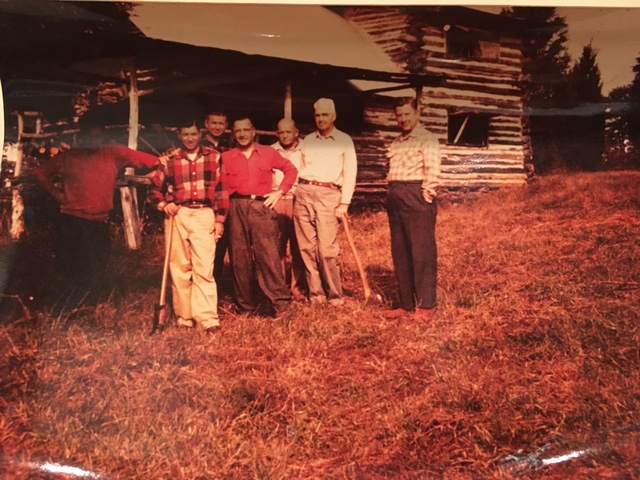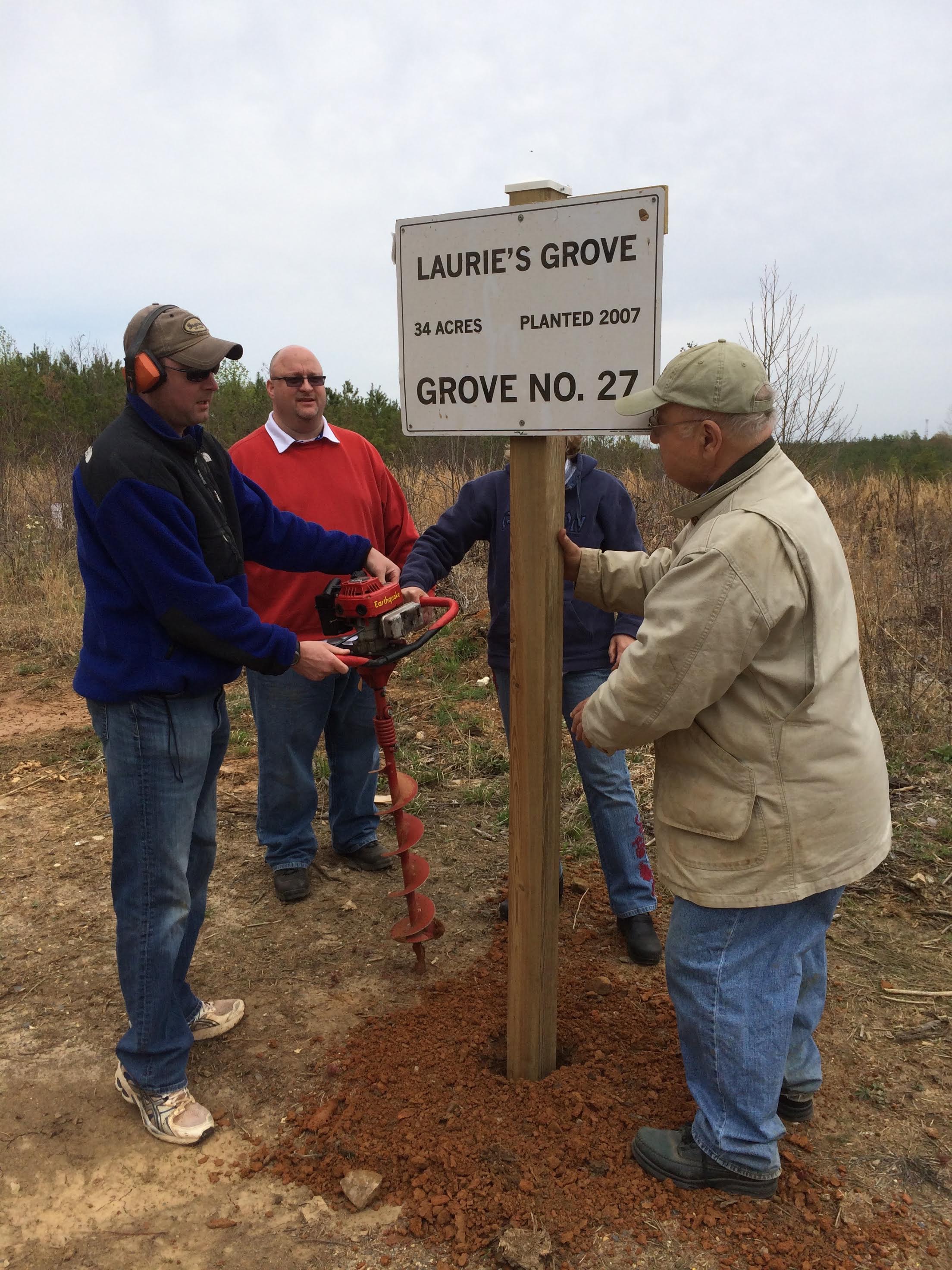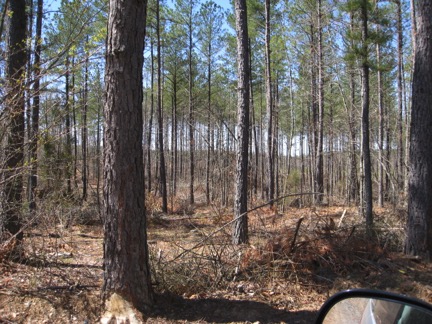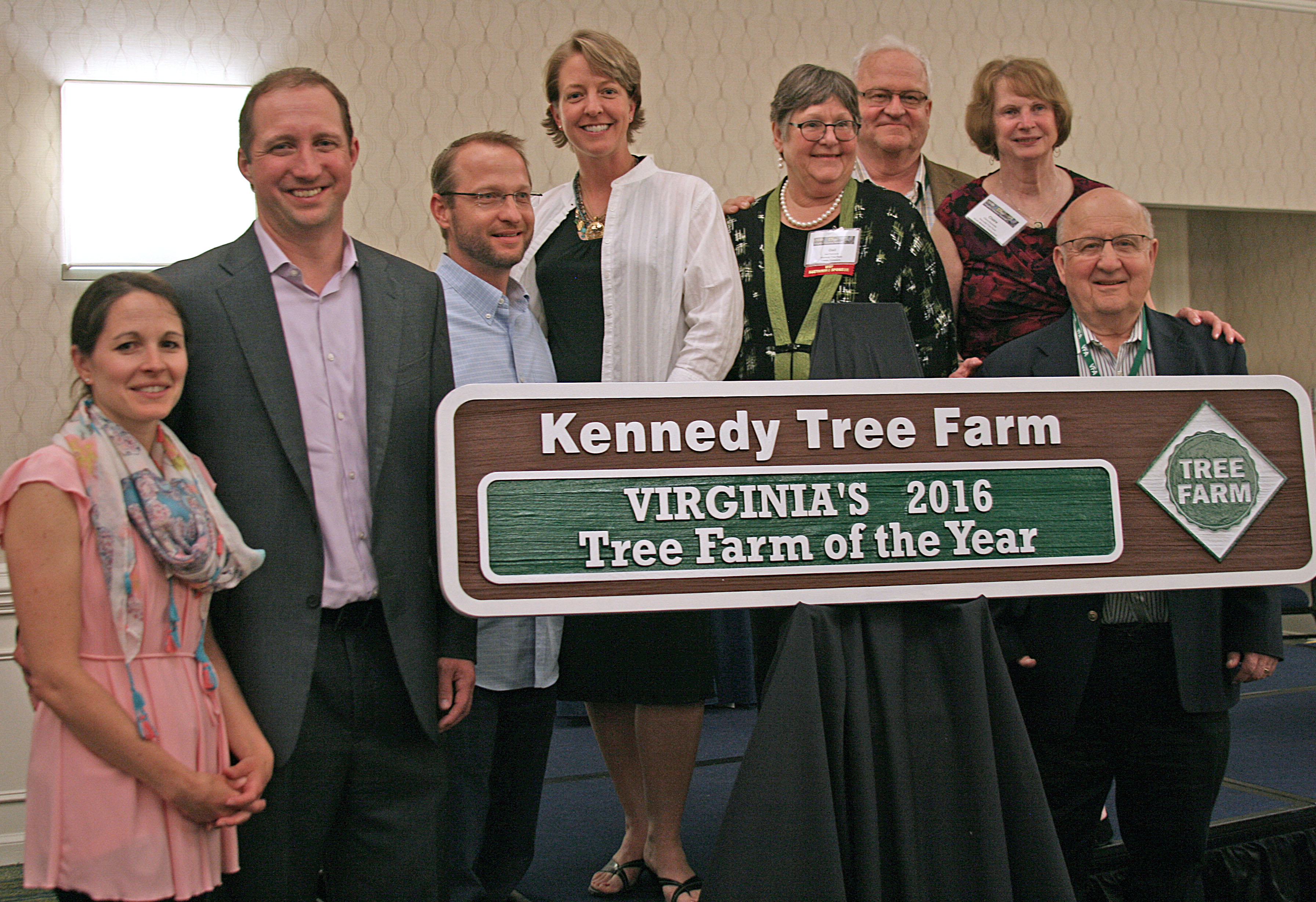Mr. Kit Kennedy and Mr. Jan Kennedy from Virginia
 What Makes Them Outstanding?
What Makes Them Outstanding?
The Kennedy family’s work on their Tree Farm began by doing small timber cutting and reforestation projects in an effort to improve the timber conditions and properly manage the property. One of the more unique situations for this property is that the Kennedy family has invited friends and business associates to the tree farm for a week every fall to participate in work such as prescribe burning, road maintenance, operating a sawmill, and performing other duties around the property. This served as an opportunity for individuals to fellowship; learn about the forest, and to discuss things of interest not only here in our country but around the world. The property has been used for forestry research projects by students from VA Tech and bird studies by students from Longwood University. Hunting activities are also allowed for members of a local hunt club who help maintain the roads and look after the property when the Kennedys are not around. As time has passed, the size of the projects has increased, and the intensity of the management work has grown.
They work very closely with their consulting forester who methodically follows their Stewardship Management plan and keeps the Kennedys up to date as to when a stand needs thinning or to be clear cut and reforested. Because of their planning and hard work the quality of the timber on this property has been greatly improved. The younger generation is being groomed to take over the responsibilities in a few years. Both Kit and Jan hope to keep alive the vision that their dad had way back in 1944 when the tree farm was first established. They continue to have good relationships with their neighbors, local businesses, the logging community, various contractors, the local hunt club, and other individuals in the area. The Kennedy family’s accomplishments serve as a good example to others on how to properly manage a forest.
Tree Farmer Story
Jan and Kit Kennedy have continued and expanded their Father’s legacy, the Kennedy Tree Farm, as well as continuing funding to Virginia Tech Forestry and Wildlife Research. They have ensured that the family commitment will continue with annual family gatherings and workdays on the property now including their children and grandchildren, the fourth generation. This is one of the oldest continuing Tree Farms number VA-146, first certified in 1955. Their Father Robert Kennedy was recognized as Virginia 1975 Outstanding Tree Farmer of the Year. The Kennedy Brothers continue to educate themselves as members attending meetings of the Forest Landowners Association and the Virginia Forestry Association. They also network with a wide range of resource professionals in person each October and regularly throughout the year.
History and Family Connections by Mr. Jan Kennedy, a Philadelphia, Pennsylvania native, Robert Kennedy started working in the New York City as lawyer in acquisition mergers. However his greatest fortune was in the people he knew, met and had an influence on in his and their lifetimes. When he purchase the initial 400 acres in Virginia in 1945, he found that a major forest fire had destroyed all the timber and only the large oak stumps remained upright. Reading about the reforestation and wildlife programs, pond water reserves and road systems, Robert, with the ambition to make the estate a model of progressive wildlife and forestry, began to make changes. With his new plantation, the uplands would become a managed forest of pines and hardwoods. On the low lands he developed a series of ponds and streams.
Kennedy started working in the New York City as lawyer in acquisition mergers. However his greatest fortune was in the people he knew, met and had an influence on in his and their lifetimes. When he purchase the initial 400 acres in Virginia in 1945, he found that a major forest fire had destroyed all the timber and only the large oak stumps remained upright. Reading about the reforestation and wildlife programs, pond water reserves and road systems, Robert, with the ambition to make the estate a model of progressive wildlife and forestry, began to make changes. With his new plantation, the uplands would become a managed forest of pines and hardwoods. On the low lands he developed a series of ponds and streams.
After the passing of Robert and William Kennedy, Robert's sons, Kit and Jan Kennedy have continued to pursue Robert's far-sighted approach to wildlife, recreation, water and forestry. Kit and Jan have increased the size to almost 1500 acres, instituted a Forest Stewardship management plan with the great help of their private forester, Bob Warring. The management and 5 year expenditure and reforestation plans manage 31 hardwood and pine units with an average size of 48 acres. There are four lakes and ponds, two homes, 2 cabooses, a sawmill and 20 miles of walking and automobile trails.Their legacy of stewardship is being continued and enhanced by the third generation: Todd, Kory, Kyle Kennedy and Holly Kennedy Camlin as well as their children, the fourth generation.
The Kennedy Tree Farm continues to focus on the evolution of conservation stewardship; including its history, current practice and future trends. Husband Protective League (HPL) In 1950 (66 years ago) Robert Kennedy founded the Husbands Protective League Inc. (HPL) at the Kennedy Tree Farm. Our father was concerned that most men were dying significantly earlier than their wives. Hence the men needed an organization to educate them and to help them live longer. In general, men do not have organizations, such as women do, to sit and discuss health issues or their concerns. The HPL has become a fraternal organization that is incorporated, has a president, vice-president, treasurer and secretary and meets twice a year with attendees from all walks of life and from all parts of the country. We now have had three generations of the many families coming to the HPL meetings. The camaraderie that the meetings have engendered has been great and rewarding and many changes in jobs and changes in personal directions have occurred as a result of these encounters. Our story (recently published in the August 2007 issue of the Appalachian Woodlands and Sportsmen’s Review entitled How to Run a Tree Farm) on our success in getting all these folks to come and do real work at the tree farm was really our father's success.
During this five-day period in October at the Kennedy Tree Farm we do physical work with projects to help bond the men. In addition we have talks and speakers on many subjects. The groups areas of interest include forestry, fishing and conservative issues, men's health issues, Civil War history, Virginia history, finances, politics, travel and investments. The HPL gatherings have educational and hands on experiences for those (~29) in attendance. These experiences have included lectures on all forestry issues (recently - timber supply and demand, new seedlings, growth and yield modeling and LIDAR) as well as physical work conducting understory burning, clear cut burns, fish shocking to determine the health of the fish in the four ponds, gold mine panning and tours to local forest and historical sites. The HPL motto at the entrance to the tree farm is:
- Do nothing but work
- Take nothing but orders
- Leave nothing but results
- Have nothing but fun!
Wood
 "The Kennedys are interested in learning all they can about new technologies in the field of forestry, then implementing those on their own property. Their forest management evolved as forestry has evolved in Virginia: the early trial and error days of loblolly pine management, the advent of mechanized logging and reforestation of manageable units by chopping and burning, straight planting when it became hard to do prescribe burning. Kennedys kept their Farm Manager operating as a small Logger until 2013. They have suffered the frustration ofoverstocked natural loblolly stands and precommercial thinning. They have persisted through times with no herbicides, bad herbicides, good herbicides which turned out to be bad, and today’s great herbicides. Always interested in better pine genetics, there is now 75 acres of Elite Varietal Clones planted on the property. Over the last few years prior to harvest each stand is evaluated to determine if it can regenerate quality hardwood trees. The Kennedys have experienced it all, following the advice of the professionals. A description of the 2013 Growth and Yield Modeling research funded by Kennedys and in part conducted on their Tree Farm is described: Jan and Kit Kennedy have a keen interest in making ecologically and financially sound management decisions when establishing and managing loblolly pine plantations on their tree farm. They have worked with Virginia Tech, including support of students, in the application of growth and yield models to guide the selection of planting density, genetic stock, competition control, thinning schedules, and fertilizer treatments to achieve their management goals. Each year they host a gathering at their tree farm to learn about the latest results from forestry research and to determine how to best apply new findings to their property." - Harold Burkhart, Virginia Tech
"The Kennedys are interested in learning all they can about new technologies in the field of forestry, then implementing those on their own property. Their forest management evolved as forestry has evolved in Virginia: the early trial and error days of loblolly pine management, the advent of mechanized logging and reforestation of manageable units by chopping and burning, straight planting when it became hard to do prescribe burning. Kennedys kept their Farm Manager operating as a small Logger until 2013. They have suffered the frustration ofoverstocked natural loblolly stands and precommercial thinning. They have persisted through times with no herbicides, bad herbicides, good herbicides which turned out to be bad, and today’s great herbicides. Always interested in better pine genetics, there is now 75 acres of Elite Varietal Clones planted on the property. Over the last few years prior to harvest each stand is evaluated to determine if it can regenerate quality hardwood trees. The Kennedys have experienced it all, following the advice of the professionals. A description of the 2013 Growth and Yield Modeling research funded by Kennedys and in part conducted on their Tree Farm is described: Jan and Kit Kennedy have a keen interest in making ecologically and financially sound management decisions when establishing and managing loblolly pine plantations on their tree farm. They have worked with Virginia Tech, including support of students, in the application of growth and yield models to guide the selection of planting density, genetic stock, competition control, thinning schedules, and fertilizer treatments to achieve their management goals. Each year they host a gathering at their tree farm to learn about the latest results from forestry research and to determine how to best apply new findings to their property." - Harold Burkhart, Virginia Tech
Water
"It is rare these days to see such large tracts owned by private entities that are operated and maintained in a way that benefits all. The Kennedys are actively engaged in the proper management of their timber operation and are working closely with their private consulting forester, our local DOF forester and our NRCS conservationists to develop and implement conservation and forest management plans that will best protect our local natural resources. Through the use of best management practices while operating their timber business, the Kennedys are examples of stewards of our natural resources and savvy entrepreneurs." - Kelly Snoddy, Conservation Specialist
"Water conservation has always been part of management considerations at the Kennedy Tree Farm, but for the past two decades the Kennedys have made special efforts in this area. Their stewardship of lakes on the property has extended from efforts to prevent sedimentation and siltation, to controlling nonnative invasive aquatic plants, to controlling beaver damage, to monitoring and managing fish populations with a sound scientific approach. In partnership with Virginia Tech, they have provided opportunities for students to get hands-on experience in fish population assessment and management. They supported a graduate student to investigate ecological interactions between two common Virginia fishes, the largemouth bass and the bluegill, and to develop approaches to improve their management. Recent efforts have included the construction of a network of submerged brush habitats to protect young fishes from predation, and experimental stocking of tiger muskies as part of a statewide effort to test these popular sport fish for use in small private lakes." - Brain Murphy
Wildlife Including Threatened and Endangered Species
The Gold Mine Hunt Club was started in the early 1950s and was officially formed in 1978 on the Kennedy Tree Farm. The club consists of 15-20 local men of all ages who hunt on the property with bow, muzzle loader and shotgun. The Hunt club pays the Kennedy Tree Farm a yearly fee based on acreage, but more importantly pays an equal or greater amount with their work on the roads, trails, grass cutting, and planting of song bird and wildlife plots. This additional work is important to the Kennedys, and they look forward each year to share stories and a wild game dinner in October with the HPL members and Kennedy family members." Approximately 12 years of Kennedy’s research funding has assisted Wildlife Research by Marcella Kelly.
acreage, but more importantly pays an equal or greater amount with their work on the roads, trails, grass cutting, and planting of song bird and wildlife plots. This additional work is important to the Kennedys, and they look forward each year to share stories and a wild game dinner in October with the HPL members and Kennedy family members." Approximately 12 years of Kennedy’s research funding has assisted Wildlife Research by Marcella Kelly.
The Kennedy Tree Farm was instrumental to me in evaluating the early remotely-triggered, infrared cameras for conducting wildlife surveys on the Tree Farm. In addition to determining the best camera models, we were able to train many Virginia Tech students and document the multitude of wildlife species on the property including bears, bobcats, coyotes, turkeys, and of course, white-tailed deer." - Marcella J. Kelly - Associate Professor, Dept. of Fish and Wildlife Conservation, Virginia Tech.
Recreation and Aesthetics Including Special Sites
Aesthetics: In the 1940s and 1950s as pine stands were planted by family members, their Father would name a stand or grove after a child. While their Forestry Consultant referrers to 31 Unit Numbers Jan and Kit still use the family member names. Now grand children have Units named after them with signs telling the year each unit was planted by a Contractor. The Kennedy Tree Farm is located in one of the most rural countys in central Virginia. Kennedys decided early on with this location, well managed timber stands did not need an aesthetic buffer along the State road in most cases. They believe a well managed stand with asign indicating the management, is a good advertisement for forestry. That being said, there are some aesthetic buffers along Route 631 and near the cabin.
Special Sites: Special Sites are considered and protected. Two old cemeteries are known and protected. One is within the cabin area aesthetic buffer. The other cemetery is painted around so that is protected from accidental timber harvest. There is an old canal on the property which was also protected in a recent timber harvest. The canal parallels Gold Mine Branch and served a gold mine just across the property boundary.
Recreation: Recreation occurs in the form of hunting, beaver trapping, fishing, outdoor work projects and family hiking. See the Wildlife section for the story of the Gold Mine Hunt Club.


